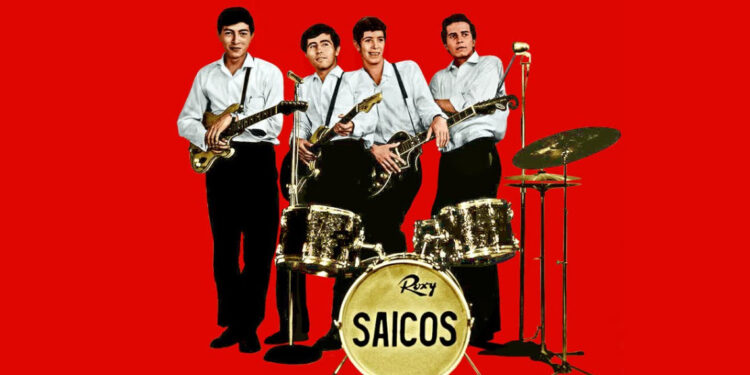When we talk about the origins of Punk, most people think of iconic bands like the Ramones or the Sex Pistols, associating the birth of this explosive genre with the American and British countercultures of the 1970s. However, few know that nearly a decade before punk exploded in those lands, a Peruvian band was already sowing the seeds of this movement. Yes, punk, as we know it, has its roots in Lima, Peru, and that root is called Los Saicos.
The Story of Los Saicos: Rebellion in the Age of Rock
It was 1964 in Lima. Rock and Roll had already arrived in Peru, and young people were immersed in the new wave of bands like The Beatles and The Rolling Stones. But a group of discontented youths, dissatisfied with the soft and melodic sounds of the time, decided to break the mold and create something entirely different—something more aggressive and visceral. Los Saicos formed in the Lince neighborhood, and their proposal was so transgressive that it seemed to come from another planet.
The band consisted of Erwin Flores (vocals and guitar), Rolando Carpio (lead guitar), César Castrillón (bass and vocals), and Pancho Guevara (drums). From the very first chord, their music bore no resemblance to anything being played on local or international radio. Their sound was raw, filled with distortion, and their lyrics were more akin to a war cry than the typical love songs dominating the era.
Some of their most well-known tracks include “Demolición”, “Fugaz,” and “Camisa de fuerza.”
“Demolición”: The Anthem of Rebellion
If there’s one song that defines the essence of Los Saicos, it is undoubtedly “Demolición.” With its famous refrain, “¡Echemos abajo la estación del tren!” (Let’s tear down the train station!), this song became the band’s banner and a perfect example of their rebellious spirit. It was unprecedented: while other groups sang about teenage romance, Los Saicos sang about destruction, chaos, and defiance against authority. This aggression and unconventionality would later characterize punk rock.

Released in 1965, “Demolición” was a hit in Peru, but its international impact took time to be recognized. The song, with its frenetic rhythm, gut-wrenching screams, and unmistakable energy, would resonate decades later in the underground punk scene, with many considering it one of the first punk songs in history.
The End of an Era: The Disappearance of Los Saicos
Despite their innovative potential, Los Saicos had a brief career. In 1966, just two years after their formation, the band dissolved. In total, they released only six singles, but those few tracks were enough to ensure their legacy endured. Unlike other bands of their time, Los Saicos did not record full albums or embark on extensive international tours, but their impact was profound and lasting.
After the band disbanded, its members went their separate ways. Erwin Flores emigrated to the United States, Rolando Carpio passed away in an accident in 2005, and Pancho Guevara died in 2015. However, in recent years, Los Saicos have experienced a resurgence, with their music being rediscovered by new generations and receiving tributes from punk bands around the world.
Punk, in its purest form, was born in Peru
The Transcendence of Los Saicos in the Global Punk Scene
Despite their short career, Los Saicos have been rediscovered and recognized internationally as one of the pioneering bands of punk rock. Their sound, characterized by aggression and a rebellious attitude, had more in common with future punk bands in New York and London than with the rock groups of their time.
Today, international recognition of the band has grown tremendously. Documentaries like “Saicomanía” (2011) and a burgeoning community of fans have placed Los Saicos on the pedestal they deserve, highlighting them as pioneers of a genre that was not fully appreciated until much later.
The music of Los Saicos, especially songs like “Demolición,” “Camisa de fuerza,” and “Fugaz,” captures the spirit of punk in a pure and authentic way. Their ability to channel youthful anger, social frustration, and the desire to rebel against norms perfectly embodies what punk rock would become years later.
Peru in the History of Punk: Los Saicos, Predecessors of the Movement
The legacy of Los Saicos is a historical milestone that highlights Peru’s talent and originality in the global music scene. At a time when the country was not featured among major music production centers, a group of young Limeños created something unique, ahead of its time, and revolutionary on a global scale.
Their impact exemplifies the power of Peruvian creativity and how innovative ideas can emerge from any place. Los Saicos placed Peru on the international musical map, demonstrating that the country can not only participate in global movements but also initiate them.
The next time someone talks to you about the origins of punk, don’t hesitate to mention Los Saicos. This Limeño band broke barriers, ahead of their time, laying the groundwork for a movement that would change music forever. Punk, in its purest form, was born in Peru, and that is more than enough reason to take pride in our roots, our culture, and the boundless creativity of Peruvians. Los Saicos not only represent a crucial part of rock history but also symbolize the rebellious and daring spirit that characterizes Peru. And that, without a doubt, is something to celebrate.
Today, their legacy lives on, and for Peruvians, their story is a symbol of the ability to break conventions and leave a lasting mark.




